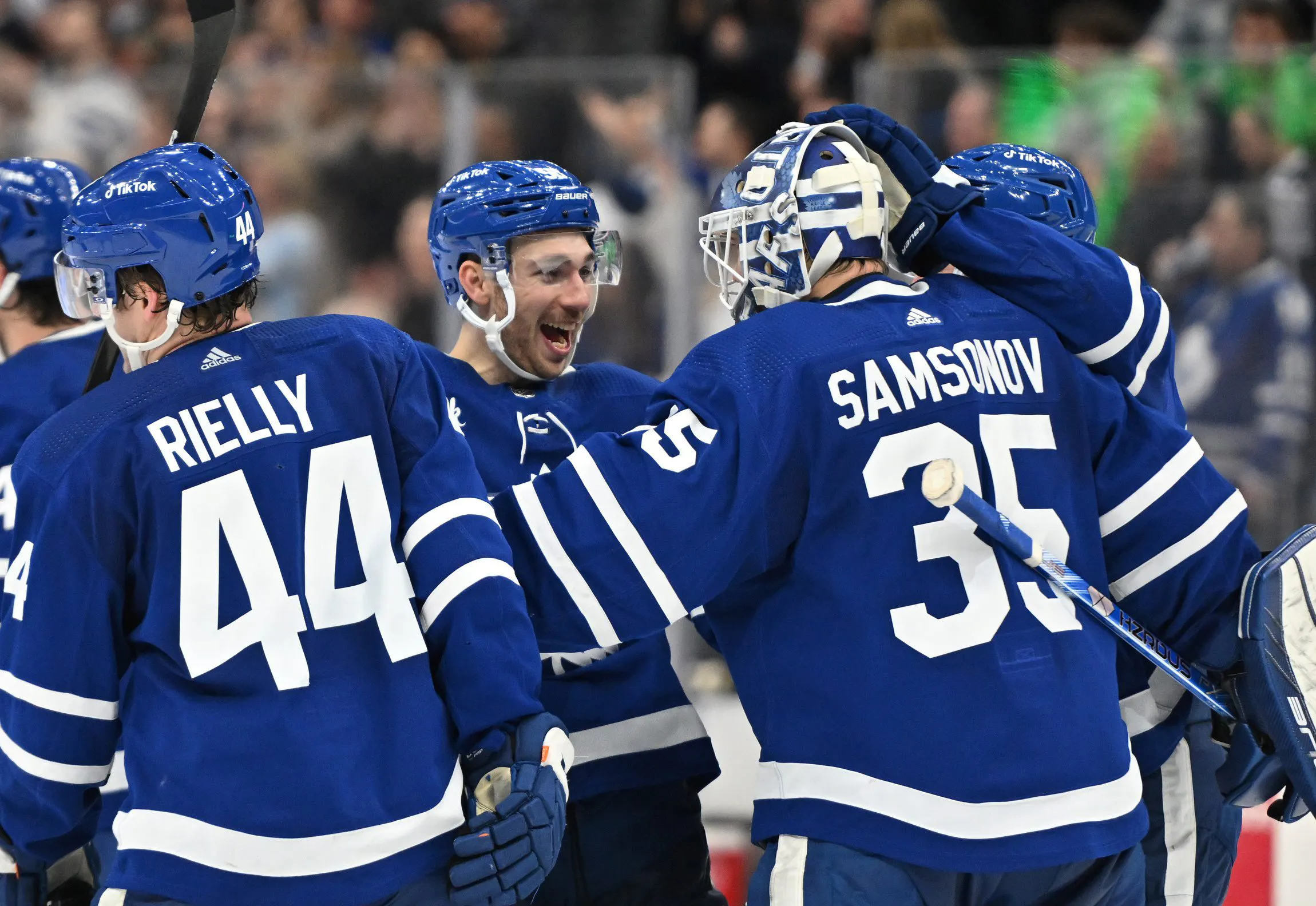The three biggest issues the next Toronto Maple Leafs GM will have to address

There’s nothing like a spicy Friday news dump.
Earlier today, the Toronto Maple Leafs announced they were moving on from Kyle Dubas, who held the most since May 11, 2018. He helped lead the Leafs to five postseason appearances and was the first GM since John Ferguson Jr. in 2004 to be credited with winning a Stanley Cup playoff series.
It was quite the ride for a man who took over for a legendary GM in Lou Lamoriello. But in the end, the Leafs decided it was time to make a change, with the team’s moving forward (for now) with assistant GMs Brandon Pridham, Ryan Hardy, Darryl Metcalf and Dr. Hayley Wickenheiser. So if the Leafs are looking to promote from within, there are more than a few options available.
At the moment, we’re not sure what route the Leafs will decide to take. But with the NHL Draft just over a month away, with the start of the free agency period opening just a few days later, that decision will come soon. Heck, maybe Brendan Shanahan will take a more hands-on approach.
We don’t know who’ll be the next man in charge, but they’ll have a big task ahead of them in a short period of time. There are mixed feelings in the fanbase about how to tackle the future: are they going to blow things up and try fresh, or just retool once again? There’s no easy answer.
While we wait to see who takes control, here’s a look at what the biggest tasks ahead for the next general manager of the Toronto Maple Leafs:
The future of the Core Four
This, by far, is one of the hottest topics heading into the summer. Toronto’s top four forwards – Auston Matthews, Mitch Marner, John Tavares and William Nylander – have been unable to escape the headlines after another disappointing playoff run. They were great in the first round against Tampa Bay, but fell apart when it mattered against the Florida Panthers with the group combining for just two goals along the way.
Tavares and Marner are both signed north of $10 million until 2025, with Tavares boasting a no-movement clause, while Marner’s kicks in next season. Matthews and Nylander both have one more year on their deals, with Nylander ($6.962 million) likely getting the biggest raise. The four players combine for about 42 percent of the team’s salary, which makes things difficult with 10 UFAs and one RFA this summer.
The top priority this summer has to be signing Matthews to a long-term deal. He’s already making $11.64 million, so a new deal won’t be a huge increase. So, really, it’s more about fitting Nylander into the equation if they’re going to end up keeping him past next season that could be difficult before giving Marner an increase the following season.
But does moving any of them really make sense? Can you good enough value for any of them? We’ve seen that the salary cap era makes big hockey moves a huge challenge. Unless they’re getting a deal like Florida got in the Tkachuk/Huberdeau swap, you’re not likely getting fair enough value for a player of their quality.
It’s easy to point at their salaries and start screaming bloody murder. By the way, Tkachuk also failed to score in that second-round series. The reality is, look at the teams that have won the Cup in recent years – namely Tampa Bay and Colorado. Both were top-heavy, salary-wise. You need a good core to build around. You also need depth to help them out, because if the opponents can shut down your best players, you need someone else to step up. The reality? That didn’t happen against Florida, and, if we’re giving the Panthers extra credit, Sergei Bobrovsky was the best goalie in the second round. Sometimes, you just get shut down by a good creasemaster.
As Matt Larkin pointed out earlier this week, the Core Four made it clear they want to stay. They want to win. There’s no pressure like Toronto pressure, and it doesn’t help when you can’t ever seem to make progress. The Washington Capitals are a good example of a team that took close to a decade with its core to make it through. Maybe you just got to keep pushing at this point.
But, you know what they say about insanity. So if the Leafs think it’s best to keep these four for another year, the leash will have to be extremely short. Make sure they’re healthy, give it another go. If it doesn’t work next year, then the next general manager can clean house if needed.
No pressure, new GM. But deciding what to do with these four could make or break your career right off the bat.
Shoring up the crease situation
The Maple Leafs have six goaltenders signed for next season – most notably, Joseph Woll and Matt Murray. Ilya Samsonov, a pending RFA, seems most likely to resume No. 1 duties after a great first season with the club. He was excellent after being a reclamation project from the Washington Capitals, coming over a one-year, inexpensive “prove it” deal that really seemed to pay off for all parties involved.
And then there’s Woll, who was excellent in the AHL and great when called upon by the big club. Woll has another two years signed at $766,667, giving the team some nice cap relief as a backup goaltender. There’s no question about it: he’s ready for full-time duty.
So, the big question: what’s next for Murray? The oft-injured goaltender had his fair share of ups and downs this season and holds the biggest cap hit at $4.687 million. It didn’t take a rocket scientist to know Murray’s acquisition was going to come with some major difficulties, and it reared its ugly head this year. It’s hard to have confidence in a goalie who has missed nearly 70 games since March 2022, and with Woll ready to go, the Leafs need to figure out something here.
Whether that’s trading him outright – which will either require eating heavy salary, or trading their 2023 first-round pick away – buying him out, or burying him on long-term injured reserve, there’s no easy option. Ideally, they’ll get his full cap hit off the books for the one season, but there’s just too much liability there – just like Petr Mrazek a year ago, which also resulted in Toronto moving their first-round pick.
Either way, this will be a key position to watch this summer.
Making room for UFAs
Let’s set the stage here: according to CapFriendly, the Leafs have $8,895,217 in projected cap space for 2023-24. That’s with 10 current UFAs and a potential starting goalie to deal with. There will be the full-time graduates within the system, including Matthew Knies and potentially Pontus Holmberg and Bobby McMann. But otherwise, the Leafs will still need to figure out how to clear some cap space to make this all work.
Toronto has easily one of the most interesting UFAs this summer in forward Michael Bunting. At his best, the Scarborough native is a valuable contributor who has proven he can break the 50-point barrier while playing with members of the Core Four. At his worst, he can go on long, difficult stretches of nothing, or get on the wrong side of the NHL’s Department of Player Safety. His value definitely fell after a topsy-turvey season, and keeping him might mean taking a bit of a hometown discount.
Then there’s Ryan O’Reilly, the team’s big trade deadline addition. There’s no question the 32-year-old brought value, but his best days are behind him. It might just be easiest to move on at this point, especially with tight cap constraints. Noel Acciari, who also came over in the deal, will be much cheaper, but at a lower overall value to the team. So that could make signing him difficult, too.
Then there’s Alexander Kerfoot, David Kampf, Wayne Simmonds and Zach Aston-Reese up front. Kampf was a bright spot in the bottom six and should be a target to bring back. ZAR had his moments, but he’s replaceable by someone from the Marlies. Kerfoot will likely be on his way out, while Simmonds seems destined to retire at this point.
On the blueline, Justin Holl’s struggles have been well-documented, so he seems to be another that could be moved out. Luke Schenn and Erik Gustafsson were decent depth additions at the deadline. Schenn could return if he’s willing to play for below $900,000, while Gustafsson was rarely used and likely gone.
So, it’s going to be a challenging time to manage the cap. They’ve got some depth guys that could earn promotion, and they’ll definitely be interesting to watch come July 1. But those cap constraints are a good reason why the Core Four’s future is even in question, at this point.

Discover Betano.ca – a premium Sports Betting and Online Casino experience. Offering numerous unique and dynamic betting options along with diverse digital and live casino games, Betano is where The Game Starts Now. 19+. Please play responsibly.
Recently by Steven Ellis
- The best value NHL players on the four remaining Stanley Cup playoff teams
- No Excuses: The Florida Panthers mean business during storybook playoff run
- 2023 NHL Mock Draft: Post-lottery top 16 edition
- Meet Adam Fantilli: Not your ordinary second-best prospect
- World Hockey Championship: Top NHL prospects to watch
- NHL Draft Rankings: Connor Bedard leads pre-draft lottery top 75
- Ewan Huet is looking to follow in his father’s footsteps – while still paving his own path
- Cole Hutson is already standing out for the 2024 NHL Draft
- What’s next for Matt Murray with the Toronto Maple Leafs?
- The NHL’s top 10 rookies of the 2023 Stanley Cup playoffs
- Vegas Golden Knights vs. Dallas Stars: 2023 Stanley Cup playoff series preview and pick
More from Steven Ellis
- Blackhawks’ Vanacker out to prove he belongs after late World Junior call-up
- Norway advances to top division of 2027 World Junior Championship
- Penguins’ goaltending depth has an opportunity to flourish following Tristan Jarry trade
- 2026 World Juniors Preview: Germany just hopes to stick around
- USHL’s Madison Capitols to host “Birds Aren’t Real” night, rebrand to Surveillance Swans